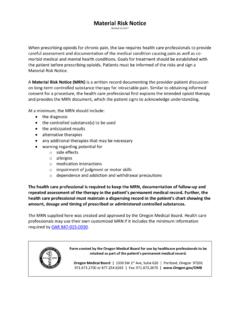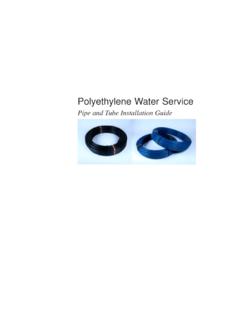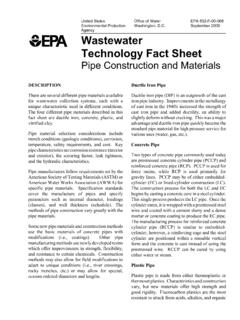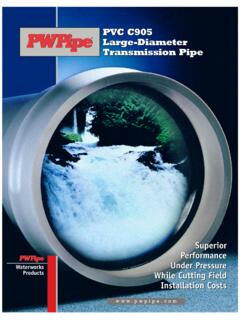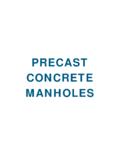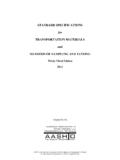Transcription of CHAPTER 5 PIPE MATERIALS - Oregon
1 CHAPTER 5 pipe MATERIALS pipe MATERIALS 5-1 CHAPTER Table of Contents Introduction .. 5-3 Policy and Practice .. 5-3 pipe Material Abbreviations .. 5-4 Definitions .. 5-4 pipe 5-4 concrete pipe .. 5-4 Metal pipe .. 5-6 CMP Wall Thicknesses .. 5-6 Plastic pipe .. 5-7 High Density Polyethylene pipe (CPEP, SRPEP, and SWPEP) .. 5-7 Polyvinyl Chloride (PVC) .. 5-7 Polypropylene pipe (CPP) .. 5-9 pipe Connections .. 5-9 Design Life.
2 5-13 Service Life .. 5-18 Fire .. 5-19 Corrosion .. 5-19 Abrasion .. 5-22 Fill Heights .. 5-26 Fill Heights for SWPVCP .. 5-27 pipe Material Selection Procedure .. 5-30 Example - Selecting Alternate MATERIALS for a Culvert .. 5-32 Example - Selecting Alternate MATERIALS for a Storm Drain .. 5-36 April 2014 ODOT Hydraulics Manual 5-2 pipe MATERIALS CHAPTER Table of Contents, Contd. --Figures-- Figure 5-1 Annular and Helical Corrugations .. 5-11 Figure 5-2 concrete pipe Connections.
3 5-13 --Tables-- Table 5-1 pipe Material Abbreviations .. 5-5 Table 5-2 Wall Thickness .. 5-7 Table 5-3 pipe Material Design Lives and Alternate MATERIALS for Culverts, Storm Drains, Subsurface Drains, Slotted Drains, Irrigation Systems, and 5-15 Table 5-4 pipe Material Service 5-21 Table 5-5 Abrasion Levels and Countermeasures .. 5-24 Table 5-6 Bed MATERIALS Moved by Various Flow Depths and Velocities .. 5-25 Table 5-7 Fill Height Table for SWPVCP .. 5-28 --Plates-- 5-1 Plan and Profile for Storm Drain Example Problem ODOT Hydraulics Manual April 2014 pipe MATERIALS 5-3 Introduction Many types of pipe MATERIALS are used in highway construction.
4 The MATERIALS must be suitable for the site conditions so the facility will perform as intended. This CHAPTER provides material selection guidance. Policy and Practice Agency policy for pipe material selection is to specify alternate MATERIALS where they can be used. Agency practice to implement this policy is in this CHAPTER . This practice addresses most pipe applications. Additional material requirements or exceptions may occur for structures designed using ODOT Bridge Section policy and practice.
5 Changes to alternate material practice and policy in the interim period between CHAPTER updates will be addressed in ODOT Roadway Technical Bulletins. Guidelines and criteria for specific MATERIALS and applications are in the remainder of the CHAPTER . pipe material choices are based on all of the site conditions, and they must: satisfy project alternate pipe MATERIALS selection according to Title 23 Code of Federal Regulations (CFR) (material or product selection) provide adequate hydraulic properties such as size and surface smoothness, withstand static forces caused by the weight of the pipe , the fluid in the pipe , and the weight of the fill over the pipe , withstand static and dynamic forces caused by wheel and track loads from traffic and construction equipment, pipe installation equipment and processes, pipe maintenance equipment and processes, and turbulent and unsteady flow within the pipe .
6 Withstand internal pressure to prevent the fluid from leaking out of the pipe into the surrounding bed MATERIALS , in the case of perforated or slotted pipe , to allow fluid from the surrounding bed material to enter the pipe , provide an adequate service life in relation to the design life of the facility, withstand corrosion caused by the fluids conveyed by the pipe , withstand corrosion caused by the surrounding soil if the pipe is in contact with the soil, withstand abrasion inside the pipe from solids carried by the flow, in certain applications, withstand combustion, provide desired fish passage characteristics, be non-toxic to the surrounding environment, and satisfy other environmental requirements, satisfy local government preferences, if required, and fulfill the need for experimental installations.
7 Each culvert, storm drain, or other installation shall be studied and suitable alternate MATERIALS allowed. The alternate MATERIALS must satisfy the requirements in the preceding list. April 2014 ODOT Hydraulics Manual 5-4 pipe MATERIALS pipe Material Abbreviations There are many types of pipe MATERIALS , and the abbreviations for these names are listed in Table 5-1. Definitions Definitions and terms important to understanding pipe MATERIALS are listed in this section.
8 Additional definitions are located in the manual glossary. ASTM Acronym for american Society for Testing and MATERIALS (ASTM). ASTM is a non-profit organization that provides specifications covering the manufacture of pipes. AWWA Acronym for american Water Works Association. AWWA provides specifications covering the manufacture of pipes used in the water industry. Dimension Ratio (DR) - Sidewall thickness to outside diameter ratio as defined in AWWA specifications.
9 Standard Dimension Ratio (SDR) - Sidewall thickness to outside diameter ratio as defined in ASTM specifications. pipe MATERIALS Numerous pipe MATERIALS are used in highway construction. More than one material can be used for most applications. The most commonly used pipe MATERIALS are discussed in this section. Additional requirements are in the Notes to Table 5-3. concrete pipe There are three types of concrete pipe allowed in the ODOT alternate MATERIALS policy; non-reinforced (NRCP), reinforced (RCP), or cast-in-place (CIPCP).
10 concrete pipes are used for culverts, storm drains, subsurface drains, and siphons. They are generally limited to non- pressure (gravity flow) applications. NRCP and RCP are specified using AASHTO M 86 or M 170 classifications, respectively. The strength of the pipe increases as the class designation increases. Class 1 NRCP and Class I and II RCP lack structural strength and they are rarely used. ODOT Hydraulics Manual April 2014 pipe MATERIALS 5-5 CIPCP is allowed as an alternate material.









